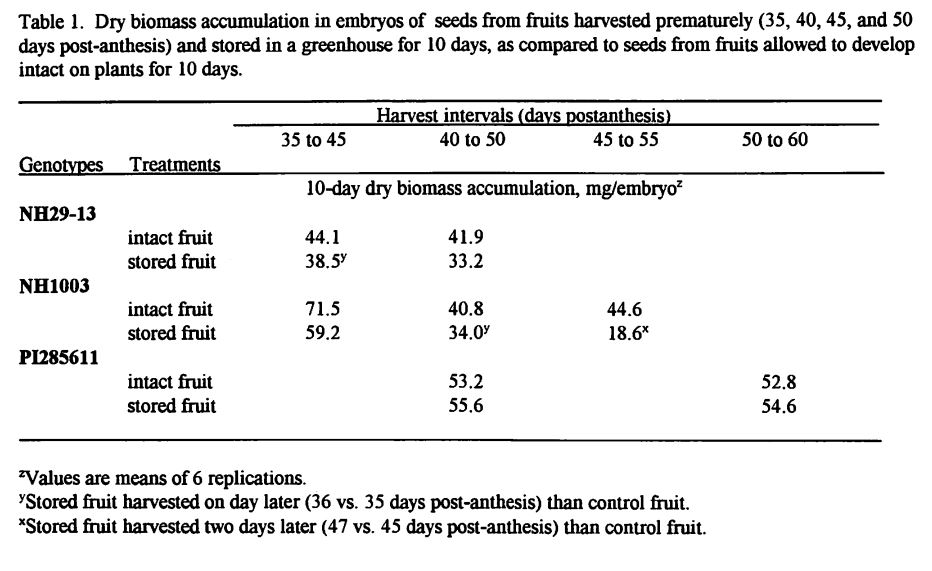Cucurbit Genetics Cooperative Report 21:57-58 (article 20) 1998
Kelly Vining and Brent Loy
Department of Plant Biology, University of New Hampshire, Durham, NH 03824
Introduction. Pumpkin plants (Cucurbita pepo L.) often senesce prematurely in the fall because of disease pressures or low temperatures. Seeds from fruit of such plans are not well-filled, and it is a common practice among breeders to store prematurely harvested fruit with the assumption that additional seed fill will occur during storage. Information on seed fill during storage of prematurely harvested fruit is important for breeders and seed producers, but is especially vital when considering cultivars developed for snackseed production. In the present study we determined the extent of seed fill in prematurely harvested fruit in three hull-less seeded, snackseed cultigens.
Materials and Methods. Three cultigens were used: P1285611 (S3), NH29-13 (F9), and NH1003, the F1 hybrid from these two inbreds. The field study was conducted in 1997 at the Woodman Horticultural Farm, Durham, NH, using a randomized complete block design with 6 replications. Hand pollinations were made between 22 July and 7 August. Fruit were harvested and initial seed weights were obtained at 5 day intervals between 35 and 50 days post-anthesis (PA). Seed fill was determined over 10 day intervals both for fruit left intact on plants and for fruit harvested from plants and stored in a greenhouse (ca. 25 to 30 C day and 18 to 21 C night). Because we had anticipated differences in fruit maturity among the cultigens, fruits for storage were not obtained for all cultigens at each sampling period.
Results and Discussion. Seed fill (calculated as embryo dry biomass) increased in 10-dy stored fruit in all cultigens and at all sampling periods (Table 1). However, the extent of seed fill in stored as compared to intact fruit differed among the genotypes. In PI285611, seed fill in stored fruit was comparable to that in fruit left on the plant (intact fruit) at both sampling periods (40 to 50 and 50 to 60 days PA). In the inbred line, NJ29-13, seed fill in stored fruit was 12.7 to 20/5% lower than that of intact fruit. In the F1 hybrid, NH1003, seed fill in stored fruit varied from 17.7 to 58.3% lower than that of intact fruit. The genotypic differences in capacity for seed fill in stored fruits probably relates directly to photosynthetic reserves in the fruits of different genotypes and at the different sampling dates. Because of their higher harvest index (higher fruit biomass to total biomass), plants of NJ1003 were more stressed from powdery mildew than plants of P1285611. NH29-13 had the highest ratio of seed fresh weight to fruit fresh weight among the genotypes, but the fruit flesh had a higher percent dry matter than the other two genotypes. PI285611 had both a lower harvest index and thicker fleshed fruit than the other two genotypes used in this study.
The results of our preliminary research on seed fill in stored fruits indicate that (1) appreciable seed fill can occur in stored fruits abscised prematurely from plants, (2) this seed fill can occur in fruits differing widely in degree of fruit maturity, and (3) there may be genotypic differences in the capacity of abscised fruits to channel assimilates into seeds, and this may represent an important selection criterion for snackseed cultivars.
Table 1. Dry biomass accumulation in embryos of seeds from fruits harvested prematurely (35, 40, 45, and 50 days post-anthesis) and stored in a greenhouse for 10 days, as compared to seeds from fruits allowed to develop intact on plants for 10 days.

Harvest intervals (days postanthesis) |
|||||
35 to 45 |
40 to 50 |
45 to 55 |
50 to 60 |
||
Genotypes |
Treatments |
10-day dry biomass accumulation, mg/embryoz |
|||
| NH29-13 | intact fruit | 44.1 | 41.9 | ||
| stored fruit | 38.5y | 33.2 | |||
| NH1003 | intact fruit | 71.5 | 40.8 | 44.6 | |
| stored fruit | 59.2 | 34.0y | 18.6x | ||
| PI285611 | intact fruit | 53.2 | 52.8 | ||
| stored fruit | 55.6 | 54.6 | |||
z Values are means of 6 replications.
y Stored fruit harvested one day later (36 vs 35 days post-anthesis) than control fruit.
x Stored fruit harvested two days later (47 vs 45 days post-anthesis) than control fruit.